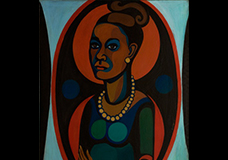![]()
![]()
![]()
![]()
![]()
![]()
 The National Museum of Women in the Arts in Washington, DC is pleased to announce summer exhibitions and programming related to the special exhibitions of Bice Lazzari : Signature Line, American People, Black Light: Faith Ringgold’s Paintings of the 1960s and Awake in the Dream World: The Art of Audrey Niffenegger.
The National Museum of Women in the Arts in Washington, DC is pleased to announce summer exhibitions and programming related to the special exhibitions of Bice Lazzari : Signature Line, American People, Black Light: Faith Ringgold’s Paintings of the 1960s and Awake in the Dream World: The Art of Audrey Niffenegger.
Faith Ringgold is best known as the originator of the African American story quilt revival that began in the 1970s,. Her exhibit, Black Light: Faith Ringgold’s Paintings of the 1960s, will be on view at the National Museum of Women in the Arts (NMWA) June 21–Nov. 10, 2013. The exhibition explores the emotional and at times contentious issues that were at the forefront of her experience of racial inequality in the United States during the 1960s. Ringgold created bold, provocative paintings in direct response to the Civil Rights and feminist movements.
With only a few exceptions, these once influential paintings disappeared from view, omitted from critical art-historical discourse for more than 40 years. The exhibition includes 45 works from the landmark series American People (1963–67) and Black Light (1967–71), along with related murals and political posters.
“In this important anniversary year for the Civil Right movement, NMWA is proud to show these little known but important early paintings by Faith Ringgold. This engaging and challenging exhibition reflects the depth of Ringgold’s work and the compelling issues she addresses,” said NMWA Director Susan Fisher Sterling. “Art and activism in the 1960s broadened opportunities within the art world for women artists, a goal that we continue to strive for at the National Museum of Women in the Arts.”
During 1963, the year of the March on Washington, the 100th anniversary of the Emancipation Proclamation, and the political assassinations of Medgar Evers and John F. Kennedy, Ringgold began work on a series of 20 paintings entitled American People. Rendered in a style that synthesizes post-cubist Picasso, pop art, and traditional African sculpture and textiles, these paintings present subjects black and white, male and female, and rich and poor. In her words, “American People is about the condition of black and white America and the paradoxes of integration felt by many black Americans.”
The first painting in the American People series, Between Friends (1963), delves into the challenges of integration. Two other paintings in the series, The Flag Is Bleeding (1967) and Die (1967), examine the hierarchies of power and equality.
As a result of the violent uprisings that took place in many U.S. cities in the mid-1960s, Ringgold’s activist politics and her art evolved. In 1967, she continued her exploration of race through the series Black Light, celebrating the diversity of complexions among African Americans and examining standards of beauty within the “black is beautiful” movement. Perceiving the color black as emblematic of African Americans’ cultural and political “invisibility,” Ringgold developed dark, tonal studies of abstracted faces reminiscent of African masks in works such as Big Black (1967).






